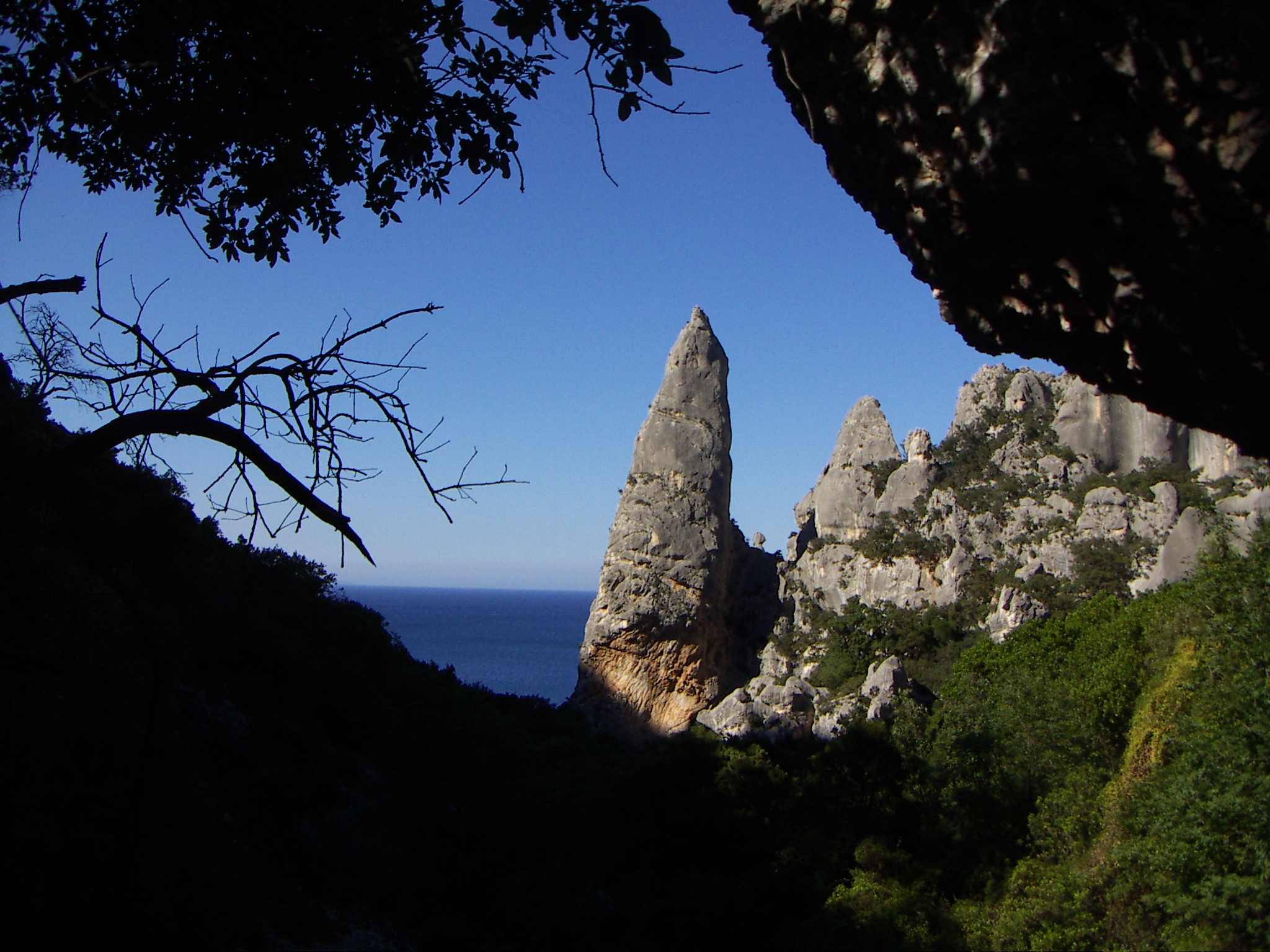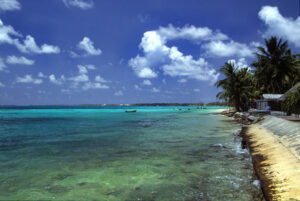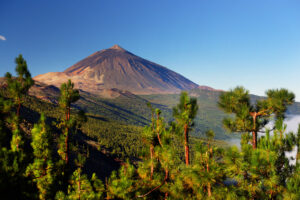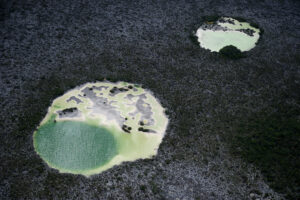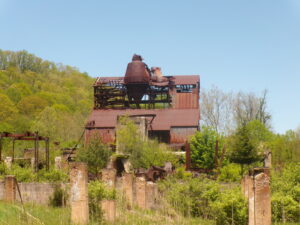The second-largest island in the Mediterranean, Sardinia’s charm lies in its wild landscapes, its heavenly beaches, and the mistral wind that blows away the summer heat, giving relief to hikers and climbers.
One of Sardinia’s best areas for hiking and climbing is the Gulf of Orosei, which stretches 30km along the eastern coast, bordered by the foothills of the Supramonte massif. A week to 10 days is enough to see the highlights. It is certainly enough to contract “Sardinian disease,” a terrible feeling of nostalgia that will make you want to return as soon as possible.
Here are 10 activities and places to try.
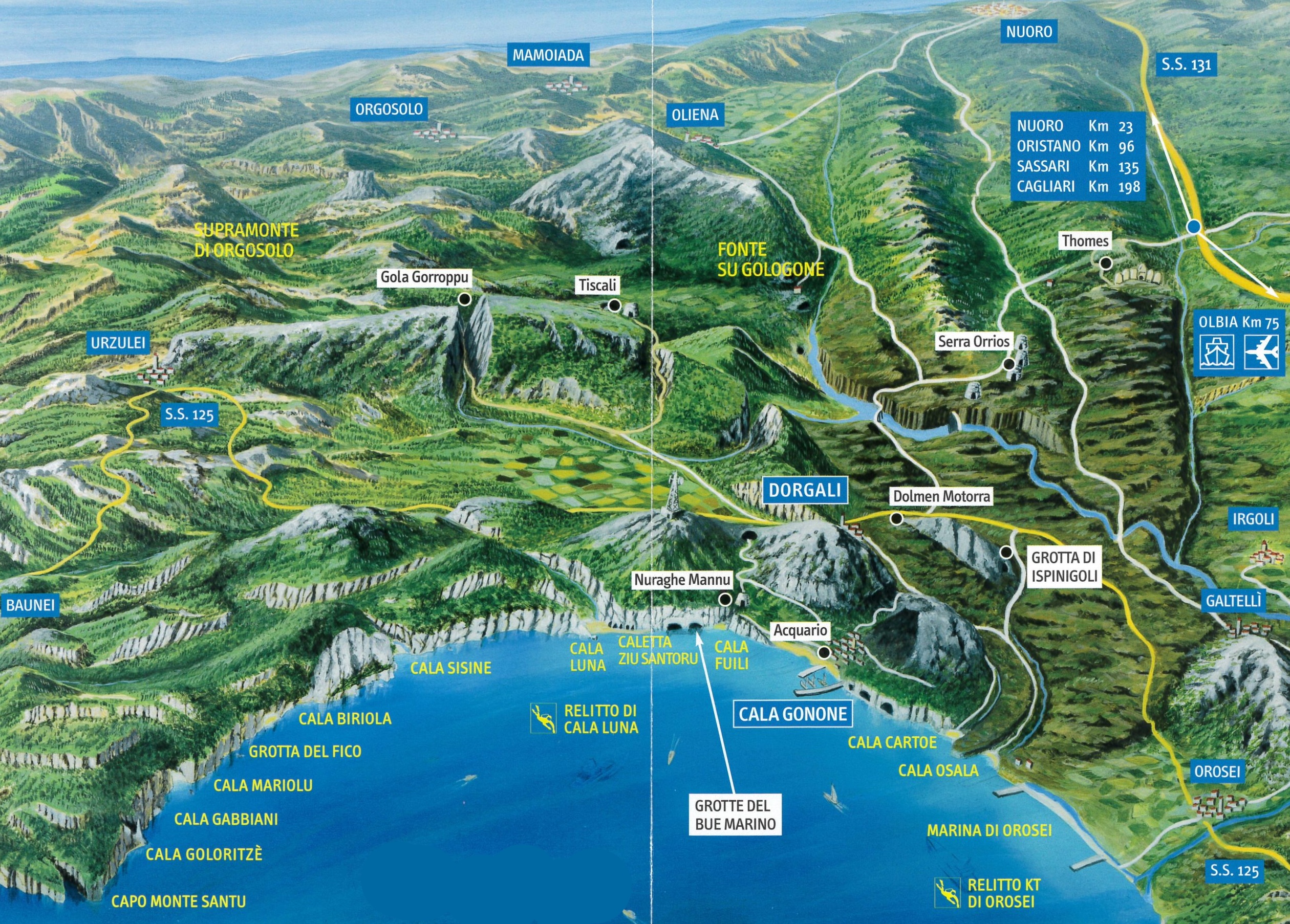
The Gulf of Orosei.
1. Cala Goloritzé, the best beach in the world (plus an iconic climb)
A few weeks ago, The World’s 50 Best Beaches of 2025 awarded first place to Cala Goloritzé, for “its wild beauty that has the power to captivate at first sight.”
In the 1980s, two well-known Italian climbers — Maurizio Zanolla and Alessandro Gogna — had already discovered its potential. But they didn’t focus on the beach but rather on the extraordinary climbing potential of the Aguglia, a massive free-standing needle that towers above Cala Goloritzé. The limestone walls appeared to offer slab climbing in amazing surroundings.
Manolo and Gogna first summited the feature in December 1981, along a route they called Sinfonia dei mulini a vento (“Symphony of the windmills”). Today, Aguglia has many routes. One of the most popular is Sole incantatore, opened by Maurizio Oviglia in 1995. Aguglia’s summit is a once-in-a-lifetime experience for many climbers.
To reach Aguglia (and the beach), drive to Baunei and then follow the signs for Ristorante del Golgo. After a 10km drive to Ristorante del Golgo, turn right to Cala Goloritzé’s official parking area, near Bar Su Porteddu. From there, it is an easy one-hour hike on an obvious uphill path. At the end, it slopes gently downhill to the beach and Aguglia.
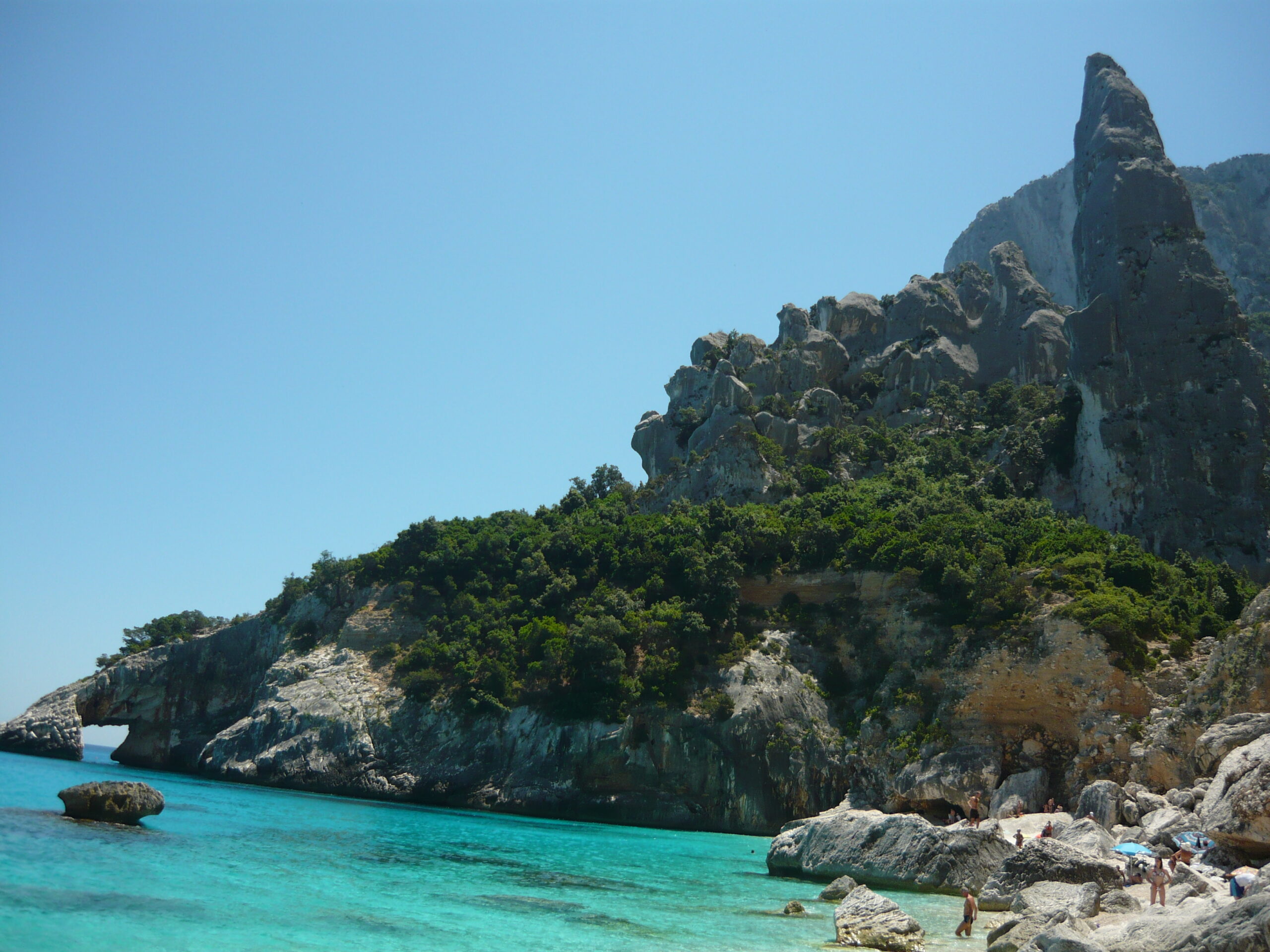
Cala Goloritzé. Photo: Monica Malfatti
2. Cala Luna, Lina Wertmüller’s bay
Hiking and swimming are a perfect combination in the Gulf of Orosei. Take Cala Luna, for example. Located halfway between the towns of Baunei and Dorgali, it was the set for Lina Wertmüller’s 1974 masterpiece, known as Swept Away in English. If you, too, want to be “overwhelmed by an unusual fate in the blue sea of August” — that is what the title means — Cala Luna’s outstandingly blue sea is the ideal place.
The bay owes its name (“luna” means moon) to an 800m sandbar that looks like a white crescent moon, with six enormous caves that open onto the beach. You reach the beach after a six-kilometer hike, immersed in the trees and overlooking the coast.
The hike to Cala Luna begins at another nice beach, Cala Fuili, and the last cove reachable by car or bike from the nearby village of Cala Gonone. Start early to enjoy the sunrise and a first swim in Cala Fuili. Then hike to Cala Luna before midday to avoid the hottest hours and the crowds.
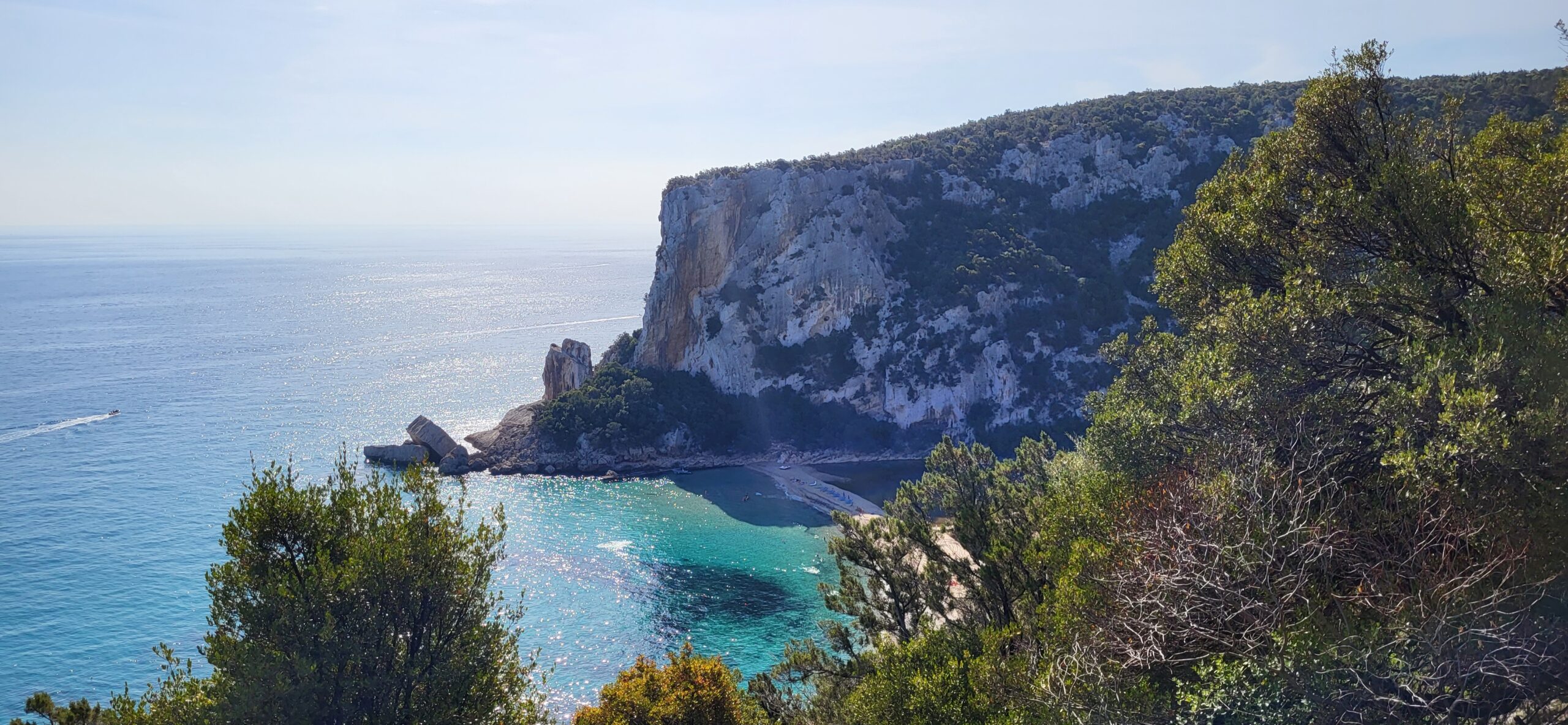
On the hike that leads to Cala Luna. Photo: Monica Malfatti
3. Selvaggio Blu, the most challenging trail in Italy
Conceived in 1987 by photographer and alpinist Mario Verin with the help of Peppino Cicalo, president of the local branch of the Italian Alpine Club, Selvaggio Blu extends for over 40km from Santa Maria Navarrese to the beach of Cala Sisine. On average, the trail takes four days to complete.
The trail’s creators wanted to raise awareness of Sardinia in the outdoor community. They created it by restoring old mule tracks, marking the route, and training local mountain guides. A guide is actually recommended, both for route finding and for help with the more exposed sections, rated up to grade IV on the UIAA Scale. After each stage, you sleep outside, in caves or tents.
The best time for Selvaggio Blu is in late spring or early fall. Many local guides organize trips, but not all guides are UIAGM certified. Contacting the local guide office in Cala Gonone, run by the UIAGM guide Stefano Michelazzi.
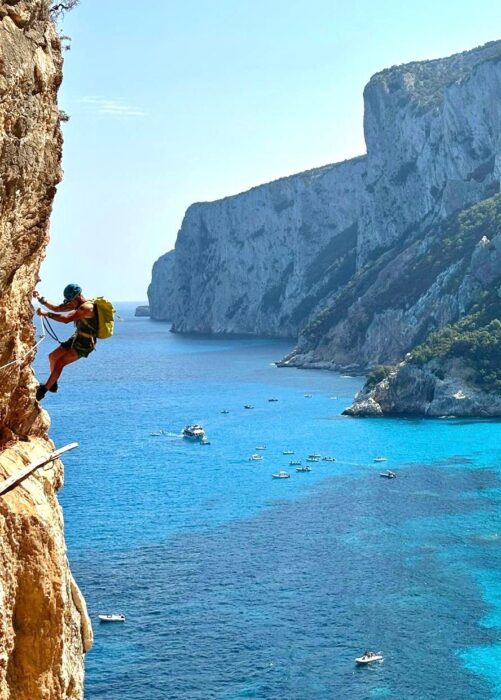
Selvaggio Blu. Photo: Franco Ramus
4. Gorropu Canyon
In May 1999, Rolando Larcher and Roberto Vigiani set up a multipitch climbing route, following strict ground-up ethics, in Sardinia’s most spectacular canyon: Gorropu. Hotel Supramonte is now one of the world’s best-known climbing routes, with a name that comes from a song by Fabrizio De Andre, one of Italy’s most famous songwriters. A 400m line, up to an 8b lead to the top, it has attracted many famous climbers: Stefan Glowacz, Beat Kammerlander, Steve McClure, Cedric Lachat, Nina Caprez, and Adam Ondra (onsight, in 2008). But if you’re not as good at climbing as they are, there are plenty of hiking routes to explore.
Hikers pass gorgeous views of barren cliffs, Mediterranean vegetation, and a juniper forest. The starting point is usually Passo di Ghenna Silana, 30 minutes by car from Dorgali and Cala Gonone. From there, you can choose between various paths.
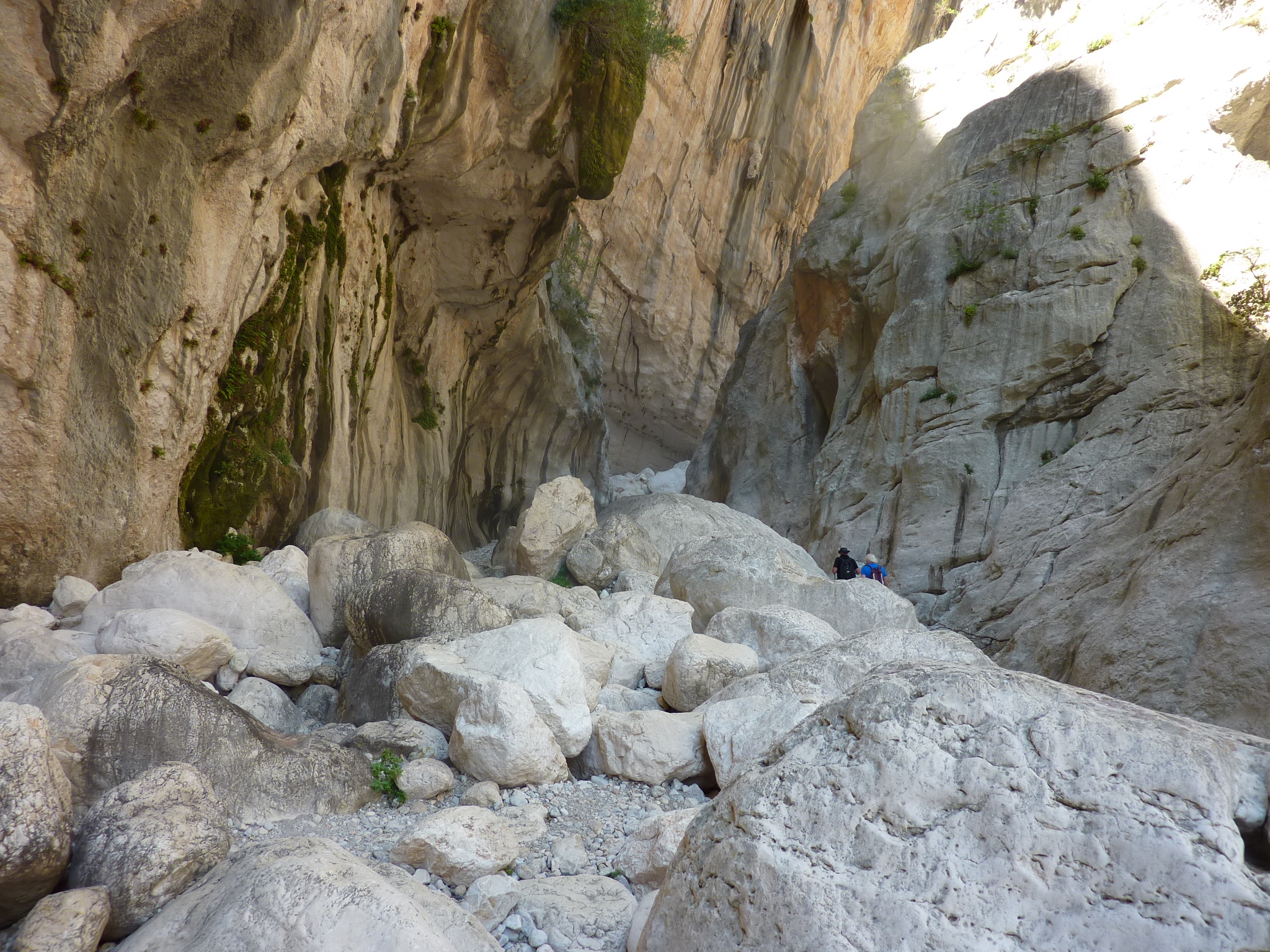
In the Gorropu Canyon. Photo: Monica Malfatti
5. Monte Oddeu, a multi-pitch playground
If you want to try more multi-pitch climbs near Gorropu Canyon — but need something easier than Hotel Supramonte — Monte Oddeu is the best and most accessible area. Located above the Flumineddu River between the canyon and the ancient village of Tiscali, it is only 12km from Dorgali. The routes are 200m high on average, with a grade range from 6a to 7a.
From Dorgali, follow the signs to Gorropu and Tiscali, driving on a wiggly road toward the valley below. There are parking spots by the bridge that crosses the Flumineddu River. Walk over the bridge and turn right towards Tiscali, following a narrow footpath on the left which enters the woods. Keep left, walking by a wire fence to the base of the wall. Most of the routes are sport climbing, with some mixed and a few trad.
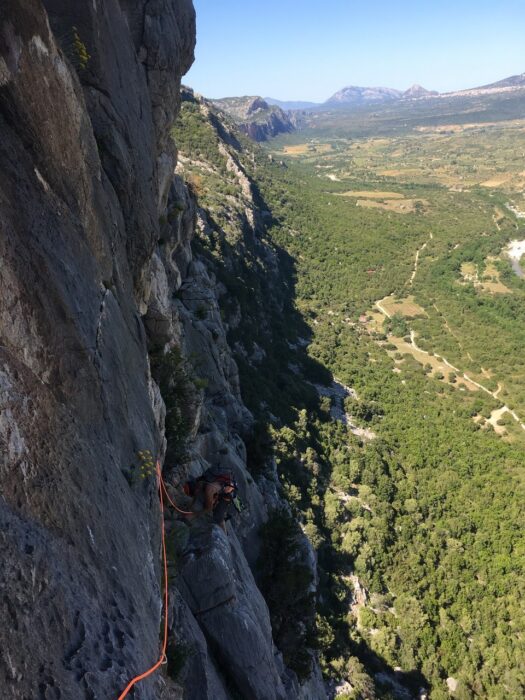
Climbing on Monte Oddeu. The above route is called Compagni di viaggio. Photo: Monica Malfatti
6. What about the crags?
Sardinia and Cala Gonone were famous for their crags years before Greece and Kalymnos. Rediscovering them while most European climbers are focused on the Greek island is a good idea. We suggest five crags in particular.
Bidiriscottai
Biddiriscottai is one of the most fascinating sea-facing crags in Sardinia. Only 20 minutes by foot from Cala Gonone, it features 60 climbing routes, spread over 250m of solid limestone. They range from easy and short to extreme overhangs.
In 2021, a massive redevelopment and safety campaign equipped most of the routes with titanium bolts.
Cala Fuili
We already mentioned Cala Fuili as a starting point for the hike to Cala Luna. If you are looking for a unique climbing crag in Sardinia, Cala Fuili is a go-to spot. The easiest walls directly face the sea, but others are located in the nearby canyon. Puschtra is the hardest section, with long and overhanging routes. The average grade is 7a, and the rock is spectacular, although it may be humid and slippery, especially when the sirocco wind blows, carrying salted sea air.
Buchi Arta
The vertical wall of Buchi Arta is not huge but has over 50 climbing lines. Natural cuts in the rock and holds that seem precisely shaped for your fingertips welcome climbers of all ages and skill levels.
Most routes are between 25 and 30m, guaranteeing a nice, long vertical journey. The base of the crag is wide and shaded until early afternoon, perfect for climbing in the morning and swimming after.
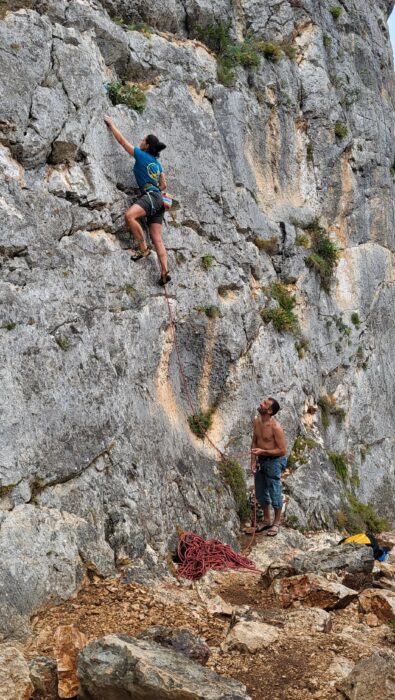
Climbing in Buchi Arta. Photo: Monica Malfatti
La Poltrona
La Poltrona is one of the oldest climbing areas near Cala Gonone. The central wall is an enormous leaning slab with about a dozen multi-pitch routes. On the lower right wall, there are many easy single routes characterized by old-style slabs that demand certain balance and precise foot positioning.
La Poltrona is thus a great “school” to learn the basics of outdoor rock climbing, especially for those who come from the gym and are looking for a safe place to practice basic outdoor skills while on holiday. Easy to reach, at the end of the main road that leads from Dorgali to Cala Gonone, there is a roundabout with the restaurant “La Poltrona” on the left-hand side. The crag is five minutes from the restaurant.
S’Atta Ruja
S’Atta Ruja is the nearest crag to Dorgali. Park the car in the town center and walk five minutes to the crag. Facing west, it is a valid alternative to sunbathing on the beach, at least during the hottest summer mornings. The routes are 25m long, with grades from 5c to 8a.
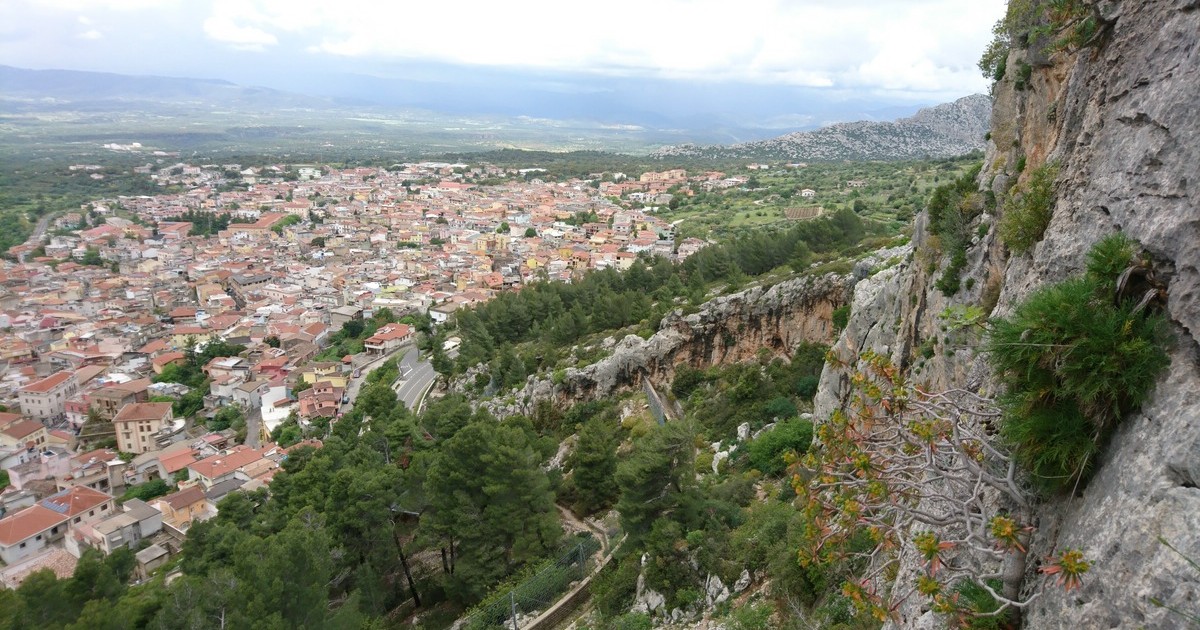
The view from S’Atta Ruja crag.
7. And in case of bad weather?
Not everyone is lucky with holiday weather. In case of bad weather, you can choose between two interesting options in the area. The Ispinigoli karst cave, a 15-minute drive from Dorgali, has been open to the public since 1974. This natural wonder contains a 38m limestone column that joins the vault to the base of the cave. Researchers found traces of human bones and jewelry dating back to the Bronze Age inside the cave, suggesting it was a burial place.
Another rainy day alternative is a brief visit to the village of Orgosolo, a 40-minute drive from Dorgali. It is the land of the Canto a Tenore, a polyphonic folk song that is part of the UNESCO Intangible Cultural Heritage. Little lanes and stone houses are enriched by beautiful paintings, which have made the village internationally famous. Many artists have contributed to the creation of an outdoor museum. Hundreds of murals color the streets and tell the story of traditions, culture, and dissent.
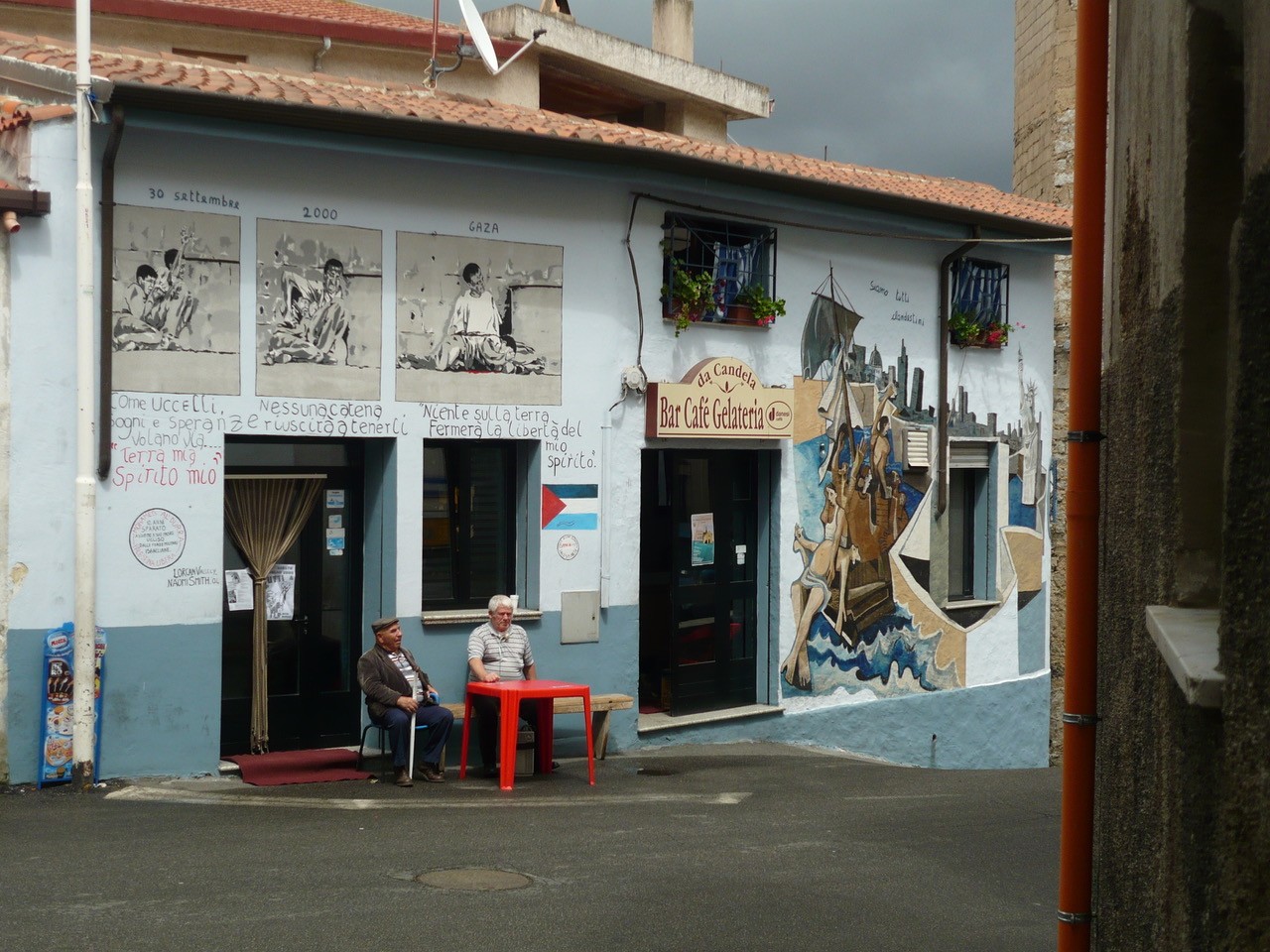
The tiny village of Orgosolo and some of its murals. Photo: Monica Malfatti
8. Lodging
Cala Gonone is the most central town to explore the Gulf, but people tend to ignore nearby Dorgali’s potential. It is not by the sea, but it is just a 15-minute drive from Cala Gonone. There are plenty of hotels, as well as rooms and apartments available for rent.
We suggest the farmhouse Conca ‘e Janas in Dorgali, where you can rent rooms at affordable prices. There’s also the Nuraghe Mannu, which is on the main road that leads to Cala Gonone from Dorgali and has a camping site for tents and vans. In both places, the food is extraordinarily good.
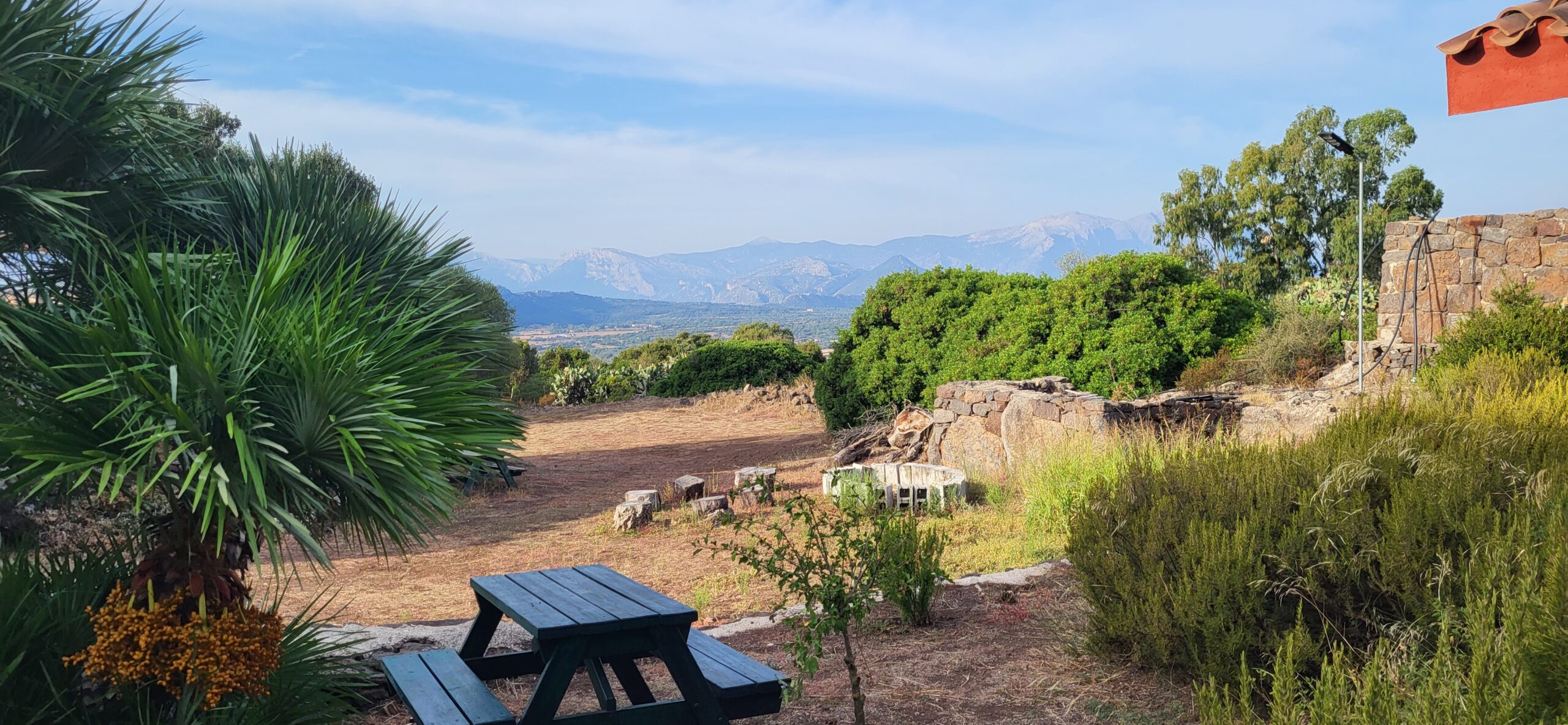
The view from farmhouse Conca ‘e Janas. Photo: Monica Malfatti
9. How to get there
The most practical and cheapest way to get to the Gulf of Orosei is by car. Italians take their car on the ferry to Olbia from Genoa or Livorno. If you fly in, you can rent a car after landing at Olbia’s airport. The road that leads from Olbia to Dorgali takes about an hour and a half.
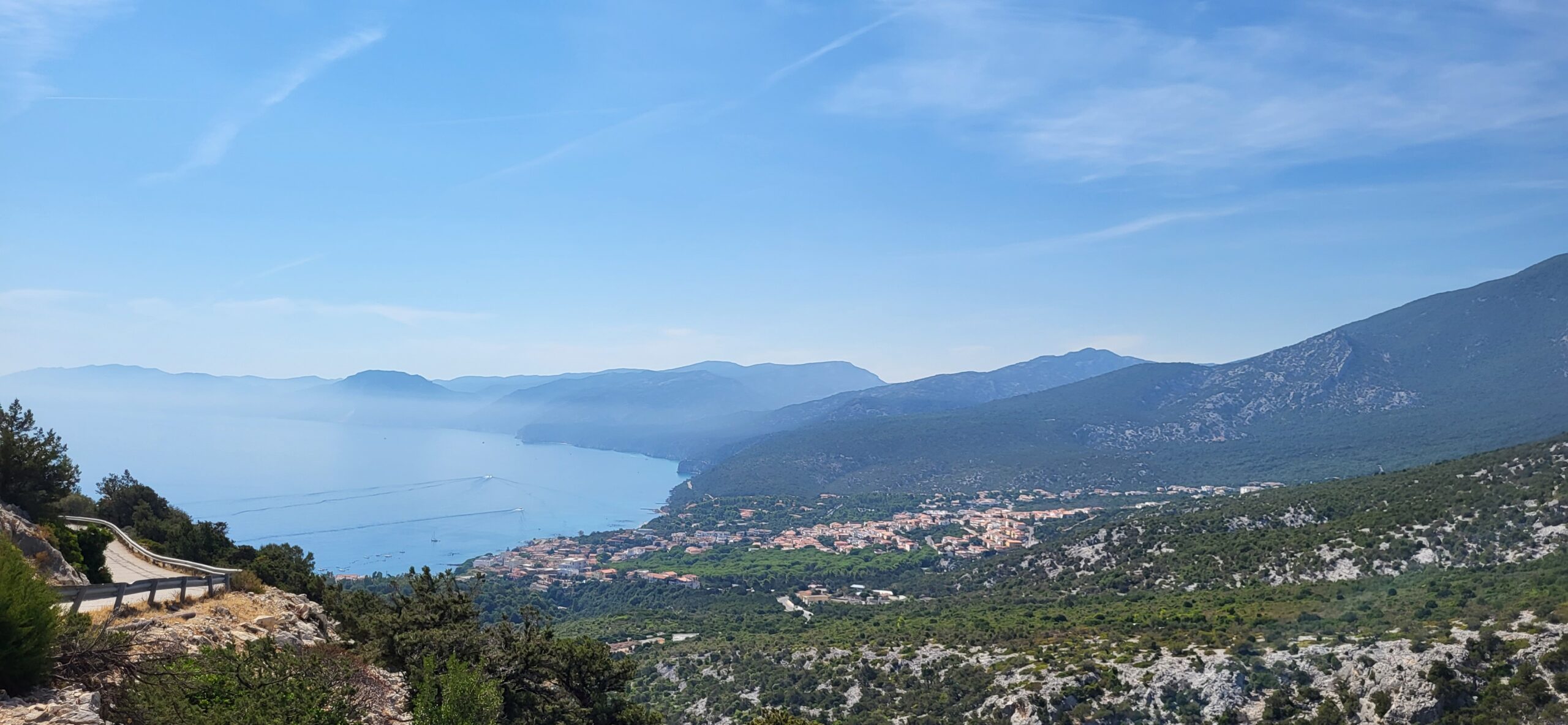
Part of the Gulf of Orosei, seen from an uphill road. Photo: Monica Malfatti
10. Other interesting things
Before leaving Sardinia, you should grab two things to take home: cheese and leather. Dorgali has both. Pelletteria Fara is a historical boutique that sells leather items at affordable prices. These are traditional products; for example, you can carry home a “taschedda,” a brown leather backpack that was used by shepherds.
Cooperativa Dorgali Pastori is ideal for those who want to discover Sardinian dairy tradition.
